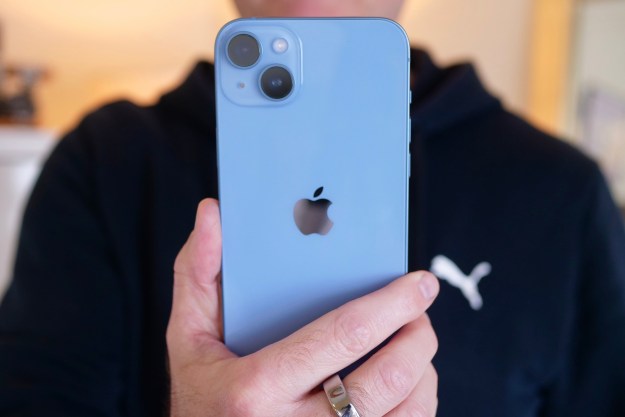Many might see the incremental improvements as pedestrian at best — Apple’s larger overhauls occur every other year — but additions such as the pressure-sensitive display help solidify a company with a few innovations up its sleeve. Now, the only question is: how does the iPhone 6S compare with its larger brethren, the iPhone 6S Plus? Check out the comparison below for a closer look at the hardware powering both models.
|
Apple iPhone 6S  |
Apple iPhone 6S Plus  |
|
| Size | 5.44 x 2.64 x 0.28 inches | 6.23 x 3.07 x 0.29 inches |
| Weight | 5.04 ounces | 6.77 ounces |
| Display size | 4.7 inches | 5.5 inches |
| Resolution | 1,334 x 750 pixels | 1,920 x 1,080 pixels |
| OS | iOS 9 | iOS 9 |
| Capacity | 16, 64, 128GB | 16, 64, 128GB |
| Processor | A9 chip with 64-bit architecture, M9 motion coprocessor | A9 chip with 64-bit architecture, M9 motion coprocessor |
| RAM | 2GB | 2GB |
| Connectivity | 4G LTE, 802.11a/b/g/n/ac, NFC | 4G LTE, 802.11a/b/g/n/ac, NFC |
| Camera | 12MP rear, 5MP front | 12MP rear, 5MP front |
| Video | 4K at 30fps, 1080p at 30 or 60fps | 4K at 30fps, 1080p at 30 or 60fps |
| Bluetooth | 4.2 | 4.2 |
| Sensors | Touch ID fingerprint sensor, barometer, three-axis gyro, accelerometer, proximity sensor, ambient light sensor | Touch ID fingerprint sensor, barometer, three-axis gyro, accelerometer, proximity sensor, ambient light sensor |
| Apple Pay | Yes | Yes |
| Battery | 14 hours of talk time on 3G | 24 hours of talk time on 3G |
| Charger | Lightning | Lightning |
| Marketplace | Apple App Store | Apple App Store |
| Avg. Price | $650, $200 with 2-year contract | $750, $300 with 2-year contract |
| Availability | September 25th on AT&T, Verizon, Sprint, T-Mobile | September 25th on AT&T, Verizon, Sprint, T-Mobile |
| DT Review | Coming soon | Coming soon |
Power and productivity
Power increases with each successor in the iPhone lineup… that much is a fact. However, like past iterations of the iPhone, it can be difficult to pinpoint how the increased processing power of each translates to real-world performance. Both the iPhone 6S and

However, much like previous models, the iPhone 6S Plus triumphs over the
Design
The processing power on the iPhone 6S and 6S Plus might be identical, but the design is not. Both iPhone models tout the same design as their predecessors, but with a few minor changes to accommodate more advanced hardware and increased color offerings. The two devices now come in a rose gold finish in addition to the silver, space gray, and gold iterations Apple previously offered. The two phones also now utilize the new 7000 series aluminum used in the Apple Watch, along with the Ion-X glass used on the Apple Watch Sport. These improvements help with durability and prevent unwanted bending. Size remains the main difference in terms of design, however, with the

Relative size aside, the iPhone 6S and 6S Plus don’t differ much. Each phone comes equipped with an faster Touch ID fingerprint sensor and touch-sensitive display, which is specifically designed to take advantage of Apple’s new 3D Touch. The feature, which bears some resemblance to the Force Torch feature in Apple’s MacBook, allows you to press down on the display with different amounts of pressure to pull up various menus, activate shortcuts, and interact with the iPhone in new ways. The Taptic Engine gracing recent entrants in Apple’s laptop line also makes an appearance on both iPhone models, providing a touch of physical feedback as you apply pressure.
Camera
Apple, understandably, likes to emphasize just how capable the iPhone camera has become in recent years. That said, the built-in cameras on the iPhone 6S and 6S Plus are identical, consisting of a 12-megapixel iSight camera on the back of the device and a 5-megapixel FaceTime HD camera on the front. The latter also allows you to capture 720p video, while the former gives you the option to record 4K video at 30 frames per second, 1080p video at 30 or 60 fps, or 720p video at up to 240 fps. The ability to record slo-mo support video and time-lapses is still there, though, only the

Price and availability
Like previous models, Apple will sell the iPhone 6S for $200 and the
Conclusion
So, which is better? Well, in the end, it really is a matter of personal preference. The iPhone 6S and 6S Plus are nearly identical when it comes to internal hardware, even if the 6S Plus does offer some slight advantages when it comes to battery capacity and optical image stabilization in the camera. Both phones boast the same processing power and exterior design, and the cost difference is pretty negligible if you opt for any sort of installment plan, which is quickly becoming the go-to method of payment among carriers. The 6S Plus is simply the best option for those looking to tap into the phablet market and get a bigger, higher resolution screen, while the 6S represents a more practical (and affordable) solution for anyone who doesn’t want such a big device.
Editors' Recommendations
- Best refurbished iPhone deals: Get an iPhone 14 for $513
- iPhone 16: news, rumored price, release date, and more
- 10 iPhone productivity apps you need to download right now
- The best iPhone 15 Pro Max cases in 2024: the 20 best ones
- The best iPhone 15 Pro cases in 2024: our 21 favorites




